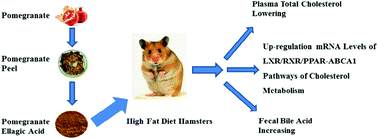Effects of ellagic acid-rich extract of pomegranates peel on regulation of cholesterol metabolism and its molecular mechanism in hamsters
Abstract
The study investigated the effect of pomegranates ellagic acid (PEA) on blood cholesterol and investigated its effects on LXR/RXR/PPAR-ABCA1 nuclear receptors-signaling pathways of cholesterol metabolism on molecular level in hamsters. In this experiment, hamsters were randomly divided into two groups: the first group (NG, n = 9) was always fed the normal diet, whereas the other group (HFG, n = 45) was fed a high fat diet during the first 4 weeks and then fed the normal diet for the last 4 weeks. In HFG, which was divided into five groups (n = 9) during the last 4 weeks, three groups were treated with PEA at 44 mg per kg bw, 88 mg per kg bw and 177 mg per kg bw, one group was treated with simvastatin at 1.77 mg per kg bw, and one was given sterile double-distilled water. The data validated that PEA dose-dependently decreased plasma total cholesterol and triglyceride level accompanied by a greater excretion of fecal bile acid. The result of RT-PCR revealed that PEA up-regulated liver X receptor (LXRα), peroxisome proliferator-activated receptor α (PPARα), peroxisome proliferator-activated receptor γ (PPARγ) and their downstream gene ATP-binding cassette transporter A1 (ABCA1), with no effect on retinoid X receptor (RXRα). PEA promoted cholesterol removal by enhancing fecal bile acid and up-regulation of the two pathways, LXR/PPAR-ABCA1. Moreover, PEA was stronger than simvastatin in some aspects.


 Please wait while we load your content...
Please wait while we load your content...